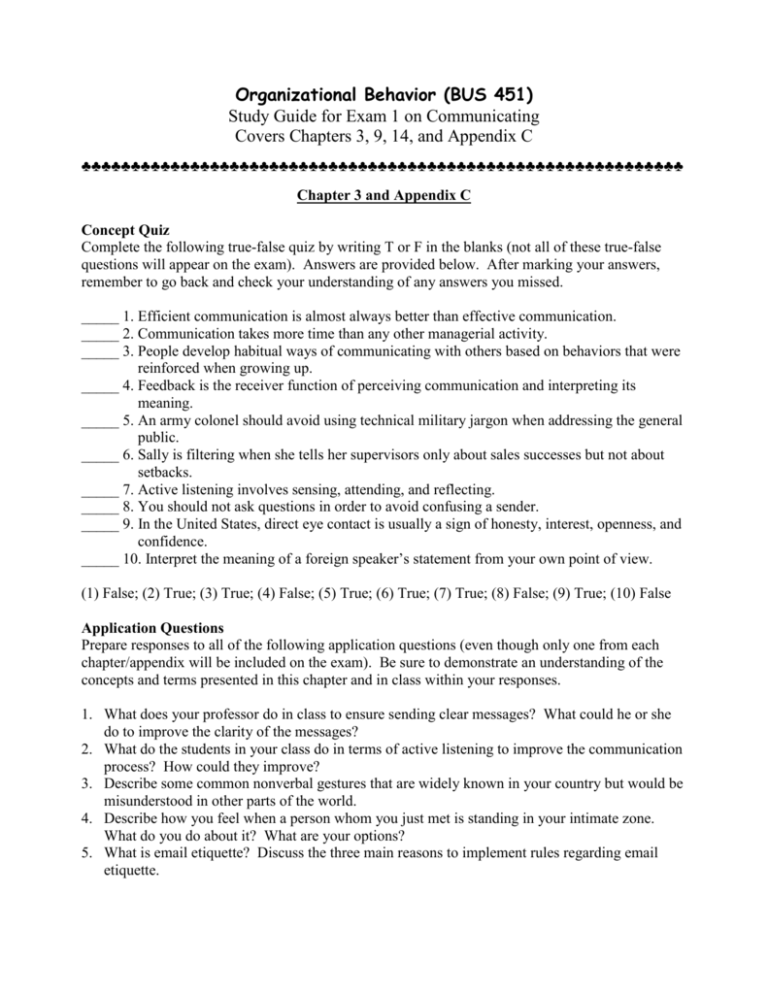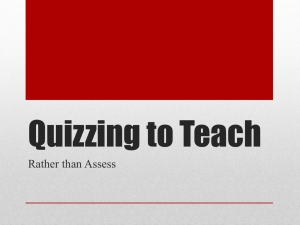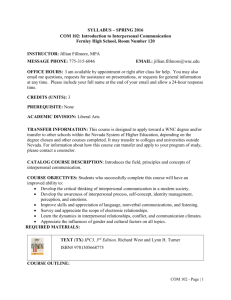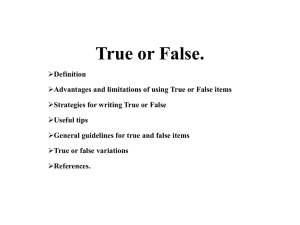Chapter 3
advertisement

Organizational Behavior (BUS 451) Study Guide for Exam 1 on Communicating Covers Chapters 3, 9, 14, and Appendix C ♣♣♣♣♣♣♣♣♣♣♣♣♣♣♣♣♣♣♣♣♣♣♣♣♣♣♣♣♣♣♣♣♣♣♣♣♣♣♣♣♣♣♣♣♣♣♣♣♣♣♣♣♣♣♣♣♣♣♣♣♣ Chapter 3 and Appendix C Concept Quiz Complete the following true-false quiz by writing T or F in the blanks (not all of these true-false questions will appear on the exam). Answers are provided below. After marking your answers, remember to go back and check your understanding of any answers you missed. _____ 1. Efficient communication is almost always better than effective communication. _____ 2. Communication takes more time than any other managerial activity. _____ 3. People develop habitual ways of communicating with others based on behaviors that were reinforced when growing up. _____ 4. Feedback is the receiver function of perceiving communication and interpreting its meaning. _____ 5. An army colonel should avoid using technical military jargon when addressing the general public. _____ 6. Sally is filtering when she tells her supervisors only about sales successes but not about setbacks. _____ 7. Active listening involves sensing, attending, and reflecting. _____ 8. You should not ask questions in order to avoid confusing a sender. _____ 9. In the United States, direct eye contact is usually a sign of honesty, interest, openness, and confidence. _____ 10. Interpret the meaning of a foreign speaker’s statement from your own point of view. (1) False; (2) True; (3) True; (4) False; (5) True; (6) True; (7) True; (8) False; (9) True; (10) False Application Questions Prepare responses to all of the following application questions (even though only one from each chapter/appendix will be included on the exam). Be sure to demonstrate an understanding of the concepts and terms presented in this chapter and in class within your responses. 1. What does your professor do in class to ensure sending clear messages? What could he or she do to improve the clarity of the messages? 2. What do the students in your class do in terms of active listening to improve the communication process? How could they improve? 3. Describe some common nonverbal gestures that are widely known in your country but would be misunderstood in other parts of the world. 4. Describe how you feel when a person whom you just met is standing in your intimate zone. What do you do about it? What are your options? 5. What is email etiquette? Discuss the three main reasons to implement rules regarding email etiquette. Chapter 9 Concept Quiz See directions above. _____ 1. A problem exits whenever the actual situation is not what is desired. _____ 2. It is more important to analyze a problem thoroughly than it is to generate many solutions. _____ 3. Flowcharts are most useful for deciding which alternative to implement. _____ 4. Pareto charts indicate which causes of problems should be solved first. _____ 5. Acceptance and implementation of action plans are enhanced by involving all affected parties in the generation and analysis of alternatives. _____ 6. The last step in problem solving is deciding on the best solution to the problem. _____ 7. Autocratic decisions often result in passive acceptance or even active resistance to implementation. _____ 8. Groupthink facilitates realistic appraisals of alternative courses of action. _____ 9. Shared responsibility is a strength for identifying who is actually accountable for the implementation of a group decision. _____ 10. Brainstorming promotes a higher quantity of far-fetched ideas. (1) True; (2) True; (3) False; (4) True; (5) True; (6) False; (7) True; (8) False; (9) False; (10) True Application Questions See directions above. 1. Explain why it is so important to establish an atmosphere of trust in situations of group problem solving. Can you cite situations in which you have not trusted others with whom you were involved in solving a problem? Compare them with situations in which you have felt trust. Have you ever felt that others in a group distrusted you? Why? 2. What four purposes are served by clarifying objectives early in the problem-solving process? Whose objectives should be considered? 3. Explain this statement: “No problem solution can be better than the quality of diagnosis on which it is built.” 4. With regard to selecting an action plan, indicate whether you agree or disagree with each of the following statements and why: (a) Experience is the best teacher (b) Intuition is a helpful force (c) Advice from others is always beneficial (d) Experiment with several alternatives. 5. What difficulties might you anticipate when using the rational problem-solving process? Why? What additional difficulties might arise because of personal attributes? Which of these have you experienced? Explain. What were the consequences? How can these difficulties be avoided? 6. Explain under what circumstances you would want to use participation to solve a problem. When would you rather solve the problem individually? 7. How can a manager encourage creative problem-solving by department members? Chapter 14 Concept Quiz See directions above. _____ 1. All teams are groups, but not all groups are teams. _____ 2. When teams are measured only on group-level performance, individual members often reduce their efforts. _____ 3. The three types of complimentary skills that a team needs to succeed are technical expertise, problem solving, and common purpose. _____ 4. The five stage of team development proceed in the following order: forming, norming, storming, performing, and adjourning. _____ 5. When a temporary team reaches an adjourning stage, a manager no longer needs to be concerned about members’ feelings, morale, or productivity. _____ 6. Task deadlines, team composition, and leader direction and support are all contingencies that can facilitate a team’s progress through the five stages of development. _____ 7. Communicating outside the group, overdependency on the leader, and hidden conflicts are all signs that a team is ineffective. _____ 8. Structuring is the most important team leadership style. _____ 9. Effective meeting planning includes all of the following: setting objectives, selecting participants, planning the agenda, and consulting with participants in advance. _____ 10. When the team is moving toward a decision, the leader should refrain from controlling the discussion. (1) True; (2) True; (3) False; (4) False; (5) False; (6) True; (7) True; (8) False; (9) True; (10) False Application Questions See directions above. 1. How would you build a high-energy team out of a group of students with differing talents, goals, and levels of motivation, who were randomly put together to complete a class project? 2. Have you ever been a member of a team that has social loafers going along for a free ride? How did this condition develop? What were the consequences? Was anything done to rectify the situation? If so, what? If not, what should have been done? 3. Contrast a team you have been on where members trusted each other versus anther group where members did not trust each other. How did these conditions develop? What were the consequences in terms of interaction patterns and performance? 4. One way to avoid conflicts at meetings is to avoid having the meeting in the first place. But if you do need to have a meeting, how would you suggest managing potential conflicts? 5. How did the last formal meeting you participated in compare with the guidelines for effective meetings presented in this chapter? What were the main differences and consequences?







